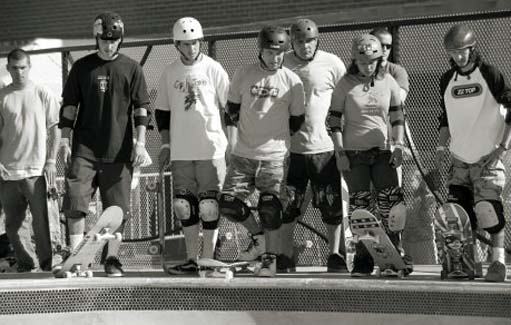5.2 ‘In-groups’ and ‘out-groups’
The two activities you did in Section 4 show how we associate ourselves with several different social categories and groups. These group identifications can promote a sense of identity and belonging – identities which help us define ourselves and others to define us. They can also raise our self-esteem and sense of status. The sense of group identity is then enhanced when we make comparisons between people like ‘us’ (the in-group) and people who are different, ‘them’ (the out-group). You can see this ‘us’ and ‘them’ thinking in many of the conflicts around the world today.
You can also see this thinking in everyday life, for instance played out with rival gangs or sporting teams. Teenage fashion is another great example. Consider, for instance, ‘skateboard culture’ and the dress code of this image-conscious group described by Janine Hunter (2006):
Members of the group are dressed in a very relaxed and informal style. Baggy jeans, T-shirts, maybe a hooded top and a key chain hanging from the side of a leg. Some have a favourite band or rock legend printed on their T-shirt, whilst others have a logo… Some of the skaters [are] wearing cut off shorts or rolled up jeans to three-quarter length, showing off their socks and trainers.
(Hunter, 2006)
Here is how one skateboarder describes the groupings demonstrating that group identity influences not only clothes but also the behaviour and ‘style’ that group members adopt:
…there's the punk skaters and then there are the rap hip-hop skaters and then … there are the people that are just, I dunno, whatever. Erm, basically you belong to one of those groups, you know, and it's the punk skaters that tend to be the ones that just throw themselves down the steps and do hand rails and stuff … and hip hop skaters tend to be like all techy, flippy crap and stuff …
(Hunter, 2006)

Activity 10: Us and them
Read the newspaper article below. Can you spot any indications of an ‘us and them’ kind of thinking? There is more than one ‘us and them’ indirectly being referred to in the article.
Ross asks BBC: ‘Where are all the black faces?’
Jonathan Ross sealed his reputation as a man willing to flirt with the unsayable yesterday when live on BBC radio he criticised the concentration of black people in low paid jobs. The target of his wrath? The BBC itself.
Ross, renown as a ‘motormouth’ chat show host, did not let his reported £6m annual pay stop him speaking his mind about his employer. Presenting his BBC Radio 2 show, he described a visit to the Chris Moyles show on Radio 1 where he met an employee with a small ‘Afro’ hairstyle. Ross demanded: ‘How many black people have they got working on proper shows there? You know the BBC still haven't really come up to speed. I mean they are trying, God bless them.’
‘Most of the guys you see there are either working on the door, carrying a cloth in there and cleaning up. We haven't really made the effort yet.’
The subject, which many employers would rather avoid, is especially sensitive at the BBC. Last year Mary FitzPatrick, its ‘diversity tsar’, told The Observer she believed foreign correspondents should be from the ethnic background of the country where they are based. She later denied this should be taken as a criticism of the likes of John Simpson and Fergal Keane for being ‘too white’.
In 2001 the then director general, Greg Dyke, labelled the BBC ‘hideously white’ and incapable of retaining staff from ethnic minorities. Last night Dyke took issue with Ross on at least one point: ‘It's certainly not true that there hasn't been an effort. While I was there I think we increased the total representation of ethnic minorities by two per cent.’
The BBC scrambled to answer Ross's broadside. A spokeswoman said: ‘The BBC is committed to ensuring that the organisation has a mixed and diverse workforce to guarantee a good understanding of the whole BBC audience, which includes people from a wide range of ethnic and social backgrounds.’
She said the BBC was aiming for 12.5 per cent ethnic minority employees in the workforce and seven per cent in senior management by December 2007. ‘As far as what Jonathan Ross said, he was expressing his personal opinions.’
(Smith, 2007)
Discussion
The clearest reference to ‘us and them’ is probably ‘blacks versus whites in the BBC’. Did you pick any others up such as ‘BBC workers versus front-line presenters’ or ‘BBC employees versus senior management’? Often, notions of ‘us and them’ are subtle and can be hard to spot unless you're a part of the in-group/out-group conflict.
Interest in the process of identification with groups received a strong impetus from a series of studies conducted in the 1950s and 1960s. Muzafer Sherif et al (1961), for instance, conducted an often cited series of experiments involving a boys’ summer camp.
Robber's Cave
The experimenters divided the boys into two groups. As expected the groups became quite cohesive involving norms of behaviour, jokes and secret codes. They set up a competition in the form of a tournament. Good sportsmanship quickly degenerated into overt group hostility with name-calling, aggression and prejudice in evidence. Within the groups, however, group loyalty, solidarity and cooperation were at its height. The experimenters then further manipulated the group situation by introducing activities which required both groups to actively cooperate and positively work together. This proved quite successful.
Experiments like these have demonstrated the significance of how conflict can arise through competition as groups interact over time. However, a series of other experiments known as the ‘minimal group experiments’ (Henri Tajfel et al 1971) shows something a little different. Tajfel and his colleagues showed that in-group favouritism and out-group discrimination can occur even when there is no history of involvement between groups. These researchers simply randomly assigned teenage boys to a kind of ‘virtual’ group. They were, in fact, working by themselves in a cubicle and just thought they were part of a group. Without any contact with others in their ‘group’ and with no real conflict of interest, they still showed in-group favouritism!
Would it surprise you to know that these results have been replicated many times in North America and Britain? However, there is also some contradictory evidence. When Margaret Wetherell (1982) applied these minimal groups in New Zealand, she found that while white European New Zealand children showed the same pattern of behaviour as North American/British children, Pacific Island and Maori children did not necessarily opt for in-group favouritism. Instead, they repeatedly chose to benefit both groups, even if this meant their group getting less than the out-group. Wetherell explains how this made sense in terms of their cultural framework. She notes, for example, that in Polynesian societies generosity is a mark of high status. Results such as these highlight the importance of wider cultural factors which affect our social identities and the extent of group influence.
Ideas about in-groups and out-groups form the basis of a psychological theory called Social Identity Theory, first developed by the psychologists Henri Tajfel and John Turner (1979). The theory argues that our response to joining groups involves three key stages:
Social categorisation: Here we put ourselves and others into categories: for example, we label someone a rapper, a snob, a trekkie, a Christian, an Essex girl, and so on. These labels then become a shorthand way of implying other things about that person. (Didn't certain images come to mind when you read those labels?)
Social identification: As soon as we are identified as belonging to one group rather than another, we take up that identity in our own and others' eyes. We become defined in a way that also has some emotional or value significance. What we and our group do is ‘good’, ‘cool’ and so forth.
Social comparison: As members of a group, we then compare our group with others. In the process, we will define our group in positive terms, thereby reinforcing our own positive view of ourselves. There is also a competitive element in our response to other groups. Out-groups are seen in negative terms, and perhaps even actively discriminated against. Thinking well of ourselves and bolstering group self-esteem therefore becomes linked with discrimination against, and hostility towards, other groups.
Social Identity Theory highlights both how people's sense of who they are is defined in terms of a ‘we’ instead of simply an ‘I’, and that in-group categorisation occurs in ways that favour the in-group at the expense of the out-group. People want to feel their own group (and therefore themselves) as being better than other groups.
Social Identity Theory is one of many different psychological theories put forward to explain some of the causes of racist attacks and group conflicts and wars around the world. While it would be too simplistic to say that all group conflicts are down to social identity (you already know that there are multiple influences on people), research evidence backs up the ideas of in-group favouritism and out-group discrimination playing a part. Prejudice based on this is a way of bolstering self-esteem in that it allows ‘out-groups’ to be seen as inferior.
The evidence suggests that the desire for self-esteem leads to inter-group competition and that these processes can escalate into open hostility and discrimination. In other words, simply categorising people into groups may be sufficient to generate conflict and prejudice between groups. The argument here is that individual differences between members of both in-groups and out-groups tend to be ignored. This results in stereotyping: the over-simplified, distorted, and one-dimensional portrayal of people, perhaps based on their sex, race, religion, profession or age. For instance, think about the stereotype of ‘dumb blondes’ which suggests that all blonde women are stupid when the reality is that intelligence is not related to hair colour. Then there are more serious examples of stereotypes, for example, when a Muslim is wrongly assumed to be a ‘terrorist’. This occurs in people's thinking as a way of simplifying and organising a complex world. The problem with such unfortunate stereotypes is that they can have problematic, even critical, consequences.
Psychologists who have studied this subject argue that as we seek to make sense of our complicated, confusing world, we inevitably stereotype people to some degree. In a sense, people have to simplify and make generalisations. The problem arises when negative caricatures result in prejudice and are used to justify discrimination against one group by another. Such portrayals can profoundly affect how we value ourselves and relate to one another in groups.
